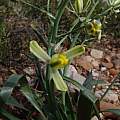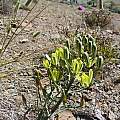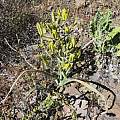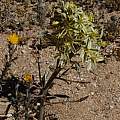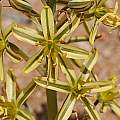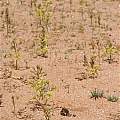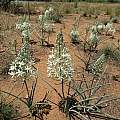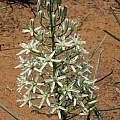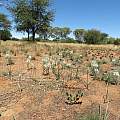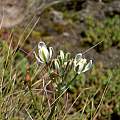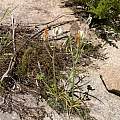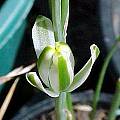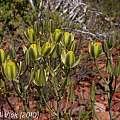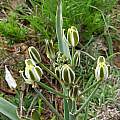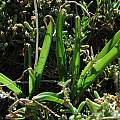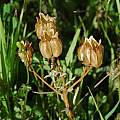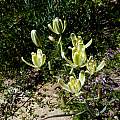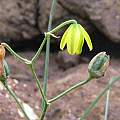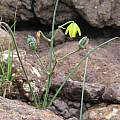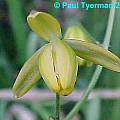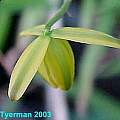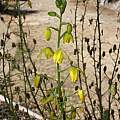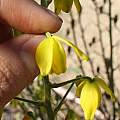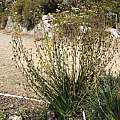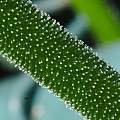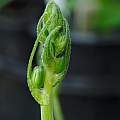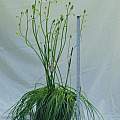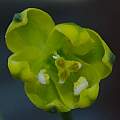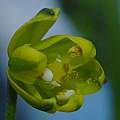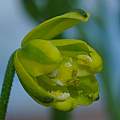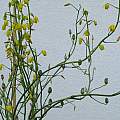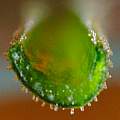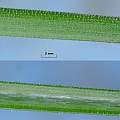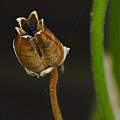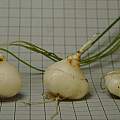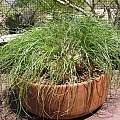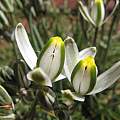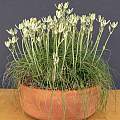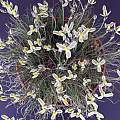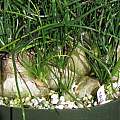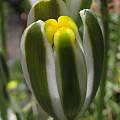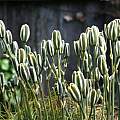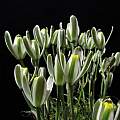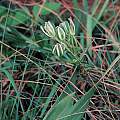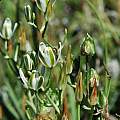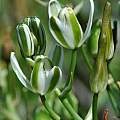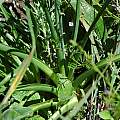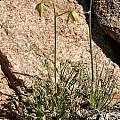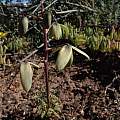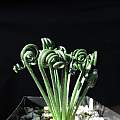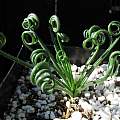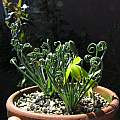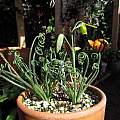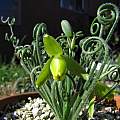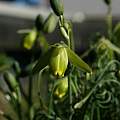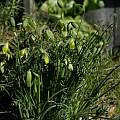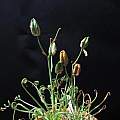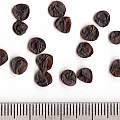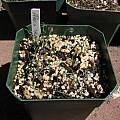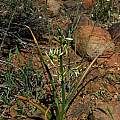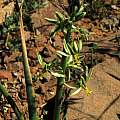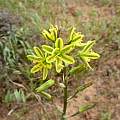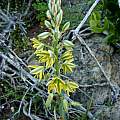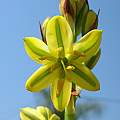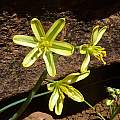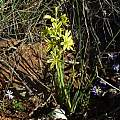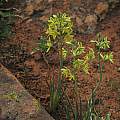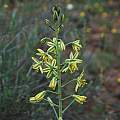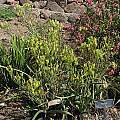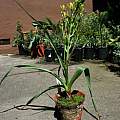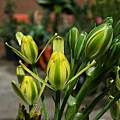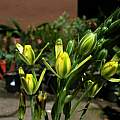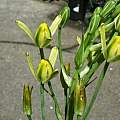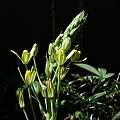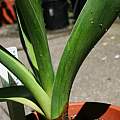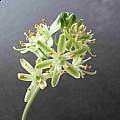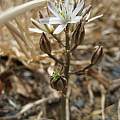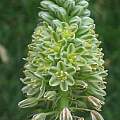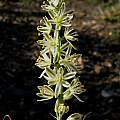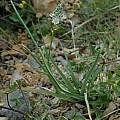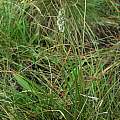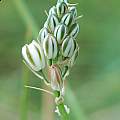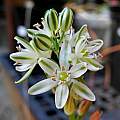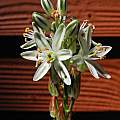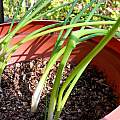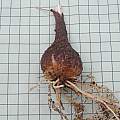Albuca is an African genus of more than 100 species belonging to the Hyacinthaceae family and includes some species more recently included in Ornithogalum. All Albuca species grow from bulbs, and most have a dormancy period after flowering whereby they lose their leaves. The flower scape is unbranched. The flowers are white and yellow and are embellished with a green to brown stripe down the middle of each outer tepal. Species Q-Z are found on this wiki page.
Albuca index - Albuca A-F - Albuca G-P - Ornithogalum
Albuca schoenlandii Baker, syn. Ornithogalum schoenlandii (Baker) J.C.Manning & Goldblatt, is distributed from the Little Karoo to the Eastern Cape where it grows on dry sandstone slopes. It is an evergreen species growing up to 50 cm with dark green flat wide leaves and white to light yellow upright flowers borne on long stalks. It flowers in spring and early summer (September to November). The first photo from the book Plants of the Klein Karoo courtesy of Jan and Anne Lise Schutte-Vlok. The last two photos from Cameron McMaster were taken near Nieuwoudtville.
Albuca secunda (Jacq.) J.C.Manning & Goldblatt, syn. Ornithogalum secundum Jacq. is found on stony slopes and flats in Namaqualand and the western Cape. It grows to 35 cm and has many oblong strap shaped leaves with minutely fringed margins arranged in a rosette and lying flat on the ground. Leaves are usually dry at flowering. The erect, many-flowered inflorescence is borne on a firm stem. Flowers are yellow with a broad green midrib with oblong spreading to recurved petals. The first photo is from Rod Saunders. The last three photos were taken in habitat by Andrew Harvie northwest of Steinkopf in Namaqualand.
Albuca seineri (Engl. & K.Krause) J.C.Manning & Goldblatt (syn. Ornithogalum seineri (Engl. & K.Krause) Oberm.) is native to Southern Africa. It is from a summer rainfall area. Height: to about 50 cm. The photos below were taken by Cody Howard of plants growing in Gobabis, Namibia.
Albuca setosa Jacq., syn. Albuca pachychlamys Baker, is found from Namaqualand, the southwestern Cape through the Karoo, Eastern Cape to Swaziland, on rocky ground, flats, and mountain slopes. Plants grow from 15-50 cm. Leaves are broad at the base, dark green. The leaves are only slightly fleshy and often dry up in dry weather, sometimes while the plants are flowering. This species has erect flowers on long pedicels, white or yellow with broad green to brownish central stripes with the inner tepals sometimes tipped yellow. There are a lot of tough fibers at the top of the bulb (also described as coarse brown hairs around the base of the plant at ground level.) This species flowers from August to January in habitat. The first two photos were taken by Cameron McMaster in the Amatola Mountains in the Eastern Cape of what was then considered to be Albuca pachychlamys. In 2022 it is considered to be a synonym of this species. The third photo below was taken by Paul Tyerman of a plant in cultivation.
The first photo is from the book Plants of the Klein Karoo courtesy of Jan and Anne Lise Schutte-Vlok. Photos 2-5 from Cameron McMaster and Mary Sue Ittner show this species growing in very dry areas of the Eastern Cape. Photos 2-3 show it flowering in January near Cradock and the last two pictures show the leaves and the remains of the seedpods. Photo 6 was taken by Cameron McMaster near Nieuwoudtville September 2012.
Albuca shawii Baker (syn. Albuca trichophylla Baker) is native from the Eastern Cape to Limpopo Province, South Africa. It can be found from 150-2400 m on cliffs and rocky grasslands. The leaves are narrow and covered with short sticky hairs, reputedly smelling of aniseed when crushed! Flowers are few, approximately 15 mm, yellow (with green stripes), nodding and scented. Plants grow to about 30 cm. Blooming time is September to February in habitat. The species is summer growing, and winter dormant. It is one of the more commonly grown species because of the profusion of flowers it produces. This is a worthy species for a nice container garden. It is named for the Scottish botanist John Shaw (1837-1890). Photos below were taken by Cameron McMaster February 2008 in Lesotho.
Photos 1-2 were taken by Paul Tyerman, 3-5 were taken by Nhu Nguyen at the UC Santa Cruz Arboretum, and photo 6 of the seeds was taken by David Pilling.
Photographs by David Pilling; the hairs are a distinctive feature and are present on leaves and stems; the stem in photo 1 is 2-3 mm wide, which makes the hairs a fraction of a millimeter long; to the eye they look more like a white fuzz; photo 2 is more representative of their appearance. Photo 2 shows all of the buds at a stem top; from the spacing of the flowers in other photos it is apparent that the stem elongates as the flowers open. Gently rubbing the stems between your fingers will release the scent. In photos 4-6 the typical situation for this genus of alternate anthers being different can be seen.
Photo 1 is of a seed pod; photo 2 shows seed pods point up, flowers down. Photo 3 displays the leaf C cross section; cutting one will cause a drop of liquid to form immediately. Photo 4 has views of the back and the front of a leaf - the inside of the C with no hairs faces the stem (bottom in the photo). Photo 5 shows the seeds in a ripe seed pod. Photo 6 is of bulbs on a 10 mm grid, the bulb on the right is upside down.
Albuca sp. 'Augrabies Hills' (ex. Arid Lands?) is a commonly sold plant. Its place of origin and species have been the subject of a PBS list discussion highlights of which can be seen below.
Dylan Hannon reported that he received plants from Arid Lands Greenhouses and was told they were grown from seed collected in the Aughrabies Hills. This is a dry area in the northwest Cape near the southeastern Namibian border. Augrabies falls is a waterfall on the Orange River, in the northwest Cape near the Namibian border; the native people called it the "place of big noises" from which the settlers derived the name 'Augrabies', sometimes written 'Aughrabies' and applied it to various features in the area stretching West. The plant that everyone grows resembles an Eastern Cape species, Albuca polyphylla. Nhu Nguyen examined his plants and found that they keyed out very closely to the description for that species. One difference, however, is that that plant according to Elsa Pooley in Mountain Flowers does not have yellow on the tepals. If seed for this plant was collected in the area that it was reported to be collected in it couldn't be Albuca polyphylla since it doesn't grow there.
Until we have formal confirmation of where the seed was collected or dna confirmation of what it is, we are retaining it as an unknown species on the wiki.
It is one of the most commonly cultivated species of the genus. It can be found in many cactus and succulent nurseries. The plant has leaves that are thin (~1mm thick), glabrous, somewhat fleshy in texture, narrowly channeled where it looks almost terete. The inflorescence is about 8 inches (or 20 cm) tall with a glaucous peduncle. Each inflorescence holds 3-4(5) flowers. The flowers are similar to a few other species, except that the bulbs of this species are raised above ground and the flowers bloom when leaves are present. This is a tough species that can take various treatments from very warm temperatures to very dry conditions for extended period of time. It probably cannot stand a deep freeze because of the exposed bulbs. Pamela Slate grows her plants in Arizona under 50% shade cloth. Nhu Nguyen grows his plant under full sun in the Bay Area. It receives water year round and blooms at least twice a year. It pups prolifically and within a few years a few bulbs can multiply to the size of Pam's specimen seen below. It likes a well drained but rich organic mix (1:1 organic:inorganic works well). Give it a little bit of fertilizer during active growth. Photos 1-4 were taken by Pamela Slate of a plant in a 12 inch pot.
The photos below were taken by Nhu Nguyen.
Albuca sp. Maclear was photographed January 2010 by Bob Rutemoeller, in Maclear, Eastern Cape.
Albuca sp. Gaika's Kop the photos were taken in January 2010 by Mary Sue Ittner, in Gaika's Kop, Eastern Cape. It could be Albuca nelsonii, a robust evergreen species found on grassland and rocky slopes in southern Africa.
Albuca spiralis L.f. is distributed in the northwestern and southwestern Cape from Namaqualand to the Cape Peninsula and to the eastern Little Karoo, South Africa, growing in sandy and loamy soils. The flowers are green with pale yellow margins, nodding, sweetly scented, reportedly of butter and vanilla! The smell can be quite strong on a warm sunny day. The peduncle has glandular hairs at the base. Leaves are narrow, straight to wavy like a snake to spirally twisted with glandular hairs. The degree of spiral depends on the clone and the amount of sunlight the plant receives when the leaves started growing. Recommendations for more leaf curling are a very lean mix, not a lot of water, and a lot of light. Height: 20-40 cm. Plants are winter-growing and summer-dormant, flowering late winter to mid-spring (August-October). Some of the members of the pbs list who have grown this species in the Northern Hemisphere have found that dormancy and time of flowering varies with the plant and is not entirely predictable. The first photo below was taken in habitat in the Kamiesberg, Namaqualand by Andrew Harvie. The second photo is from the book Plants of the Klein Karoo courtesy of Jan and Anne Lise Schutte-Vlok.
Photos 1-6 were taken by Nhu Nguyen showing various leaf morphologies from seed-raised plants.
The photos below were taken by Nhu Nguyen. Photo 6 shows three-month-old seedlings (seeds from 2007 PBS Seed Sale) grown by Nhu Nguyen. The crop of adults could be seen in photo 3 taken in 2013. It took about 4 years for this species to mature from seeds.
Albuca suaveolens Jacq., syn. Ornithogalum suaveolens (Jacq.) J.C.Manning & Goldblatt, is found on dry slopes and flats in a wide area including Namibia, Namaqualand and the Cape Province. It grows to 50 cm and has narrow leaves that clasp at the base and are sometimes dry at flowering. Flowers are in a stiff erect raceme, yellow, spreading or nodding, with dark green keels. Photos 1-2 were taken by Mary Sue Ittner near Calvinia. Photos 3-4 were taken by Cameron McMaster in Elands Bay and Namaqualand. Photo 5 is a close-up of a flower in cultivation taken by Alan Horstmann.
Photos below were taken by Cameron McMaster and Mary Sue Ittner near Nieuwoudtville.
Albuca tortuosa Baker (1897) is similar to Albuca aurea, except that it comes from the Eastern Cape Province. The leaves are tough and contorts a few times along the length. Height range: 30-60 cm. The photos below by Nhu Nguyen were taken at the UC Botanical Garden of plants collected in the Eastern Cape Province. It was originally identify as Albuca setosa.
The photos below were taken by Nhu Nguyen. Photo 6 shows the mosaic virus symptoms of this species. Unfortunately because of the virus, the plant had been destroyed after setting seeds. The pods were set by microwaving the pollen for 15 seconds, mixing with fresh pollen and applied twice a day for several days.
Albuca unifolia (Retz.) J.C.Manning & Goldblatt, syn. Ornithogalum unifolium Retz., is native to Southern Africa from Southern Namibia through Namaqualand, Bushmanland and Roggeveld to the Tanqua Karoo and western Little Karoo where it grows in arid areas, deep sands, granite outcrops and quartz gravel plains. Height range: 25-40 cm. The first photo below was taken by John Grimshaw from Kamieskroon, Northern Cape, flowering at Colesbourne. The second photo is from Rod Saunders.
Albuca virens (Lindl.) J.C.Manning & Goldblatt, syn. Ornithogalum tenuifolium Lindl. is a grassland plant found in the Eastern Cape of South Africa to tropical Africa. It grows from 10 to 60 cm high and flowers November to March. Leaves vary on this species from many to few, linear to filiform. Flowers are suberect, whitish with green keels. Albuca virens ssp. arida (Oberm.) J.C.Manning & Goldblatt (formerly Ornithogalum tenuifolium ssp. aridum Oberm.) grows in stony soil in dry grassland in southern Namibia and the Northern Cape and has filiform leaves with the old bases forming a neck. Two more subspecies were named in 2009, A. virens ssp. robusta (Stedje) J.C.Manning & Goldblatt and A. virens spp. sordida (Baker) J.C.Manning & Goldblatt, although they are not listed as accepted on Plants of the World Online. The two photos below were taken by Monica Swartz and were on the Mystery Bulbs page for some time and identified as this species by Christopher Whitehouse, who wrote that it was "a very variable species across the whole of East Africa (originally divided into three subspecies but then sunk as there was no correlation between the forms and geography." This explains why the one subspecies was retained as it is located in a different area and is a different form.
Photos taken in habitat in the Eastern Cape of South Africa by Cameron McMaster, Bob Rutemoeller, and Mary Sue Ittner.
This Albuca was on the mystery bulb page but has been identified as this species. Where she lives in Coastal Northern California the leaves usually appear in February and it usually flowers in June. Photos from Mary Sue Ittner. The photo of the bulb is on a 1 cm grid.
Albuca index - Albuca A-F - Albuca G-P - Ornithogalum
